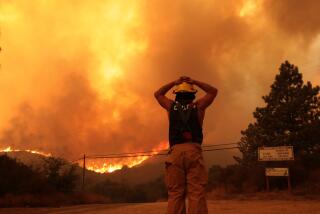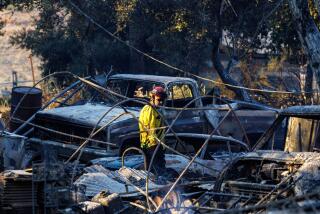Wind-Driven Infernos Char Texas Panhandle
AMARILLO, Texas — The day after wildfires roared across more than half a million acres of land, smoke hung in the air and charred earth stretched as far as the eye could see.
Two substantial fires continued to burn Monday in rural and largely uninhabited areas of the Texas Panhandle, but the 60-mph winds that fueled Sunday’s infernos had died down.
“As long as the wind stays down ... our chances are good for getting these fires under control in the next 24 hours,” Texas Highway Patrol Trooper Dan Hawthorne said.
The fires -- blamed for at least seven deaths -- were started by sparks from power lines whipped by high winds, Hawthorne said. Enormous moving walls of fire devoured the dry grass.
“When conditions get like that, you can’t keep up with the fire,” said Randy Elliott, chief deputy sheriff of Carson County. “You literally just have to stay out of the way.”
The period covering the last 12 months is the fourth-driest in Texas history. A recent series of Arctic storm systems has pushed wetter weather to the northern half of the United States, leaving the Southwest parched. Some rain is expected in the region this weekend, but officials say they are wary of more fires in coming weeks.
“We still have the dry months of April and May to go,” said Barry Goldsmith, a National Weather Service forecaster.
Dry, gusty winds blowing north from the Mexican desert also kicked up a fire in southeastern New Mexico on Sunday, burning 92,000 acres of rolling grasslands and destroying a rural post office. But that blaze was contained by early Monday, firefighters said.
“We were fortunate we didn’t lose as much as we could have,” said James Williams, deputy chief of the Lovington Fire Department.
But it was in the vast grasslands of the Texas Panhandle that the blazes were most severe. Eight towns were evacuated Sunday, though most residents were allowed to return Monday.
In the tiny oil town of Skellytown, the streets were so thick with smoke that it was hard to find the way out, resident Lucille Lawrence said. Sheriff’s deputies drove through with loudspeakers blaring as residents hurriedly sprayed their yards and roofs with water.
“They said they had given up on Skellytown if the wind direction didn’t change,” Lawrence said.
Elliott said that Skellytown was lucky. “We had airplanes that were dumping water,” he said. “That probably is what saved the town.”
Looking out her front window, Lawrence said, Monday seemed like just another day. “You can see the smoke in the distance, but there’s no fire near here,” she said.
Randy Dunham, chief deputy of the Pampa Fire Department in Gray County, said blazes there were about 70% contained. But a large fire continued to burn Monday off Interstate 40 between Pampa and McLean, he said.
Another major fire burned between Childress and Paducah in a rugged area of gullies. “It’s burning hard at a fairly rapid rate,” Hawthorne said. “You basically have to wait for it to get to an area where they can get it. They’re watching it right now.”
In Carson County, Elliott said, all that’s left are “a lot of hot spots. We’ve got firetrucks still running here and yonder to check things out, but everything’s under control.”
Reports of building damage were sketchy and unconfirmed, Hawthorne said. “We know different towns around the area lost a few structures each, but no one has had time to count them. They’ve been fighting the fires.”
Three people died in fires near the town of Borger, including an elderly man and his wife as they tried to escape their home on Sunday, Hawthorne said. Four people died in a nine-car pileup Sunday as evacuating residents traveled a smoke-obscured stretch of I-40.
Until Sunday, the largest fire in Texas history was in 1988, when 326,000 acres were consumed. Two enormous fires were responsible for Sunday’s record: east of Amarillo, 211,200 acres, and near Borger, 432,000 acres.
Times staff writer Nicholas Riccardi in Denver contributed to this report.
More to Read
Sign up for Essential California
The most important California stories and recommendations in your inbox every morning.
You may occasionally receive promotional content from the Los Angeles Times.










